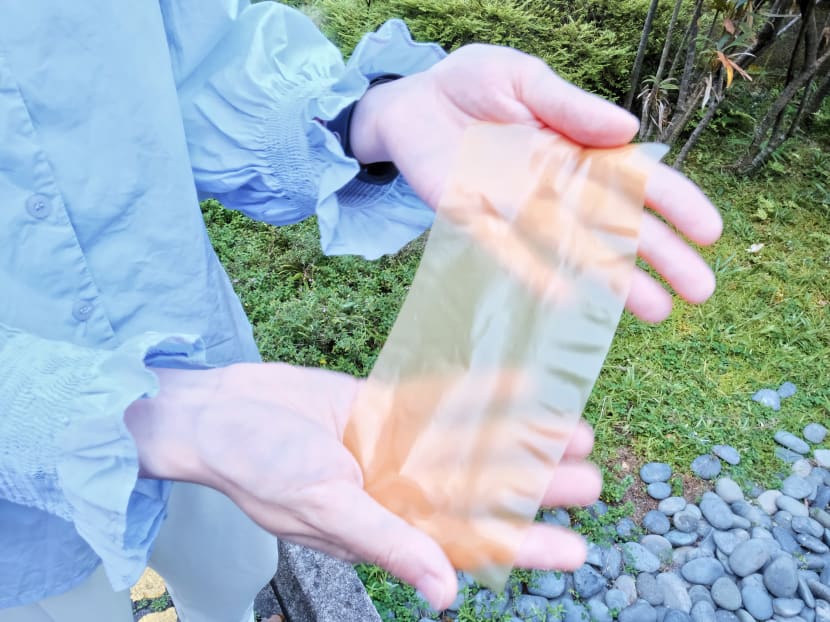NTU scientists say their eco-friendly reusable pollen-based paper could be alternative to conventional paper
SINGAPORE — Scientists at Nanyang Technological University (NTU) have developed a type of paper made from the plant material pollen that can be printed on, then erased, then printed on again up to eight times.

Scientists at Nanyang Technological University developed pollen-based paper (pictured) that may be recycled without being re-pulped, which helps to minimise carbon emissions.
- NTU scientists have developed a type of paper made from the plant material pollen
- They believe it could be an eco-friendly alternative to conventional paper
- The researchers showed that pollen paper could be printed on, erased then printed on again up to eight times
- They have filed a patent for the discovery and hope to commercialise the product
SINGAPORE — Scientists at Nanyang Technological University (NTU) have developed a type of paper made from the plant material pollen that can be printed on, then erased, then printed on again up to eight times.
They said that the pollen-based paper could become an eco-friendly alternative to conventional paper, causing less damage to the environment.
Professor Subra Suresh, NTU's president and co-lead of the research, said: “This is a new approach to paper recycling — not just by making paper in a more sustainable way, but also by extending the lifespan of the paper so that we get the maximum value out of each piece of paper we produce.”
The scientists published their research paper online in the journal Advanced Materials on Tuesday (April 5).
“This is a new approach to paper recycling — not just by making paper in a more sustainable way, but also by extending the lifespan of the paper so that we get the maximum value out of each piece of paper we produce.Professor Subra Suresh”
The NTU scientists first unveiled the pollen-based paper in November last year, when they demonstrated another use: Its ability to fold itself into certain configurations.
The material is created by adding potassium hydroxide to sunflower pollen grains. The process of transforming pollen to paper is similar to traditional soap making, a much simpler and less energy-intensive process than wood-pulp paper.
The NTU researchers found that pollen paper could be recycled without being re-pulped.
Conventional paper recycling involves re-pulping, removing printer tone and reconstruction. It is energy-intensive and contributes to rising carbon emissions.
PRINT, RINSE AND REPEAT
To demonstrate the new method of recycling pollen paper, the researchers laser-printed an image of Vincent Van Gogh’s Sunflowers series.
To "unprint", the image was rinsed off by immersing the pollen paper in an alkaline lab reagent, causing the toner layer to break away from the paper
Swollen from the "unprinting" process, the paper was left to shrink in ethanol and air-dried
After treating it with acid, the paper was ready for printing again
This process of treating pollen paper with acid, printing, then rinsing off the printed image, could be repeated another eight times without losing the quality of the paper or the printed images, the researchers noted.
In contrast, recycling techniques for conventional paper uses chemicals such as chloroform or acetone or high-intensity light to remove the toner. Both steps could damage the paper and make it unsuitable for re-printing. In addition, the use of chemicals has environmental and health risks.
COULD POLLEN PAPER REPLACE CONVENTIONAL PAPER?
The National Environment Agency said that taken collectively, paper and cardboard is the largest contributor to waste in Singapore. In 2020, 1,114 million tonnes of such waste was generated, of which 38 per cent was recycled.
The NTU researchers are seeking commercial partners on opportunities to scale up this invention. The lab is able to produce pollen paper in kilogrammes, but to replace conventional paper, the plant-based paper has to be produced in the metric tonnes.
In response to TODAY's queries, NTU said that an A4 piece of pollen paper cost about 2.4 US cents (3.3 Singapore cents) to make in a laboratory.
Using "optimised processes", that could be reduced to 1 US cent, which is comparable to conventional paper.
Prof Subra said: “With further developments in scalable manufacturing, (pollen paper) could be adapted and extended to produce other 'directly printable' paper-based products such as storage and shipping cartons and containers,”
On future possibilities of this research, Professor Cho Nam-Joon, who co-led the research, said that “by integrating conductive materials with the pollen paper, we could potentially use the material in soft electronics, green sensors, and generators to achieve advanced functions and properties”.
A patent application has been filed.






